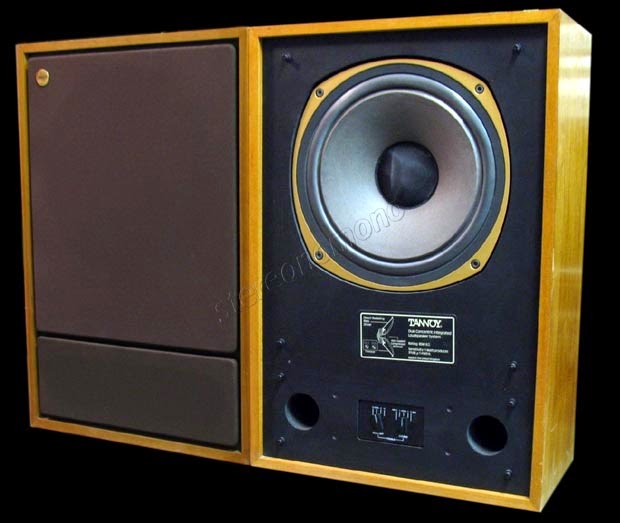BERKELEY
This system
provides the high power handling capacity and sensitivity of the HPD385A unit
in a compact enclosure where insufficient space is available to accommodate the
Arden.
A carefully
designed dual ducted port reovides optimum bass characteristics in relation to
enclosure volume, and the loudspeaker is front recess mounted to ensure
unimpeded treble response. High desnsity stock is used throughout the cabinet
construction and massive internal reinforcement renders the structure free from
spurious resonances. Each section of the two-part grille can be removed
separately to facilitate treble adjustment.
Components
Integrated
Drive System
The Tannoy
Integrated Drive System consists of a direct
radiator bass unit and a high frequency horn-loaded compression driver
both located concentrically within the same frame and magnet assembly, this is
why it is known as the dual concentric system.
Bass Unit
This is a
low resonance speaker with a 2" high temperature voice coil. The unique
Girdacoustic reinforced cone ensures true piston action and smooth performance
extending well into the midrange region.
Treble Unit
High
frequencies are reproduced by a horn-loaded compression driver utilizzing a
duralumin diaphragm and a 2" diameter aluminium voice coil.
Crossover
Network
The
crossover network receives the electrical energy fromm the amplifier and
divides it between thr high frequency compression driver and the low frequency
bass driver and makes a vital contribution to the overall performance of the
system.
Tannoy
crossover networks are of the highest quality; capacitors are non-polarized,
solid dielectric types for low lossles and close tolerances; resistors and
inductors are very generously rated; and all components are assembled on a
fibreglass printed circuit board for maximum reliability.
System
adjustment
The Tannoy
system is provided with two controls located on the front baffle. These are
labelled "Roll-off" and "Energy". They can be used to
compensate for the acoustic characteristics of the listening room and should be
adjusted with the amplifier controls in the flat or uncompensated position.
Each loudspeaker system should be adjusted individually. This is mot easily
done by rotating the amplifier Balance control to select the desired
loudspeaker.
The Energy
control has five positions and enables the output of the high frequency driver
to be increased or decreased over its entire range from 1 kHz to 20 kHz. The
Roll-off control affects only the extreme high frequencies, i.e. those above 5
kHz.
The flattest
response will be obtained with both controls set at the "Level"
position, which should be used for initial listening tests. If the overall high frequency sound quality
seems too prominent, the -1 or -2 positions for the Energy control should be
tried. If the sound is subdued +1 or +2 will be preferred. Once the Energy
setting has been established the Roll-off control can be adjusted to reduce
extreme high frequency content if necessary.
Enclosures
Tannoy
enclosures are solidly constructed from high density particle board and are
lined with acoustic foam to absorb reflections and eliminate standing waves and
bitumen to damp mechanical resonance. The exposed natural woodgrain surfaces of
each enclosure are of American Walnut veneers. The cabinets are carefully
handrubbed with oil and wax, which enhances the richness of the wood and
affords excellent protection. Both the Arden and the Berkeley are braced
internally to reduce spurious resonances which can occur in large panel areas,
and ported to provide low frequency loading, thereby reducing distortion and
extending bass response.
Specifications
Low
Frequency Direct Radiator
Maximum
Diameter: 420 mm (16 ½")
Voice Coil
Diameter: 50 mm (2")
Bl Factor in
gauss/cm: 20 x 10⁶
Fundamental
Resonance: 20 Hz
High
Frequency Compression Driver
Duralumin
Diaphragm: 50 mm (2")
Voice
Coil Diameter: 50 mm (2")
Horn Cut-off
Frequency: 500 Hz
Drive
System: 3828
Power
Handling Capacity: 85 W
Nominal
Impedance: 8 ohms
Frequency
Response: 35 Hz - 20 kHz, ±4 dB
Sensitivity;
Input Watts produce 96 dB at 1 m: 3
Crossover
Frequency: 1 kHz
System
Dimensions (H x W x D): 840 x 540 x 310
mm (33" x 21" x 12")
Weight: 41 kg (shipping)





Nessun commento:
Posta un commento